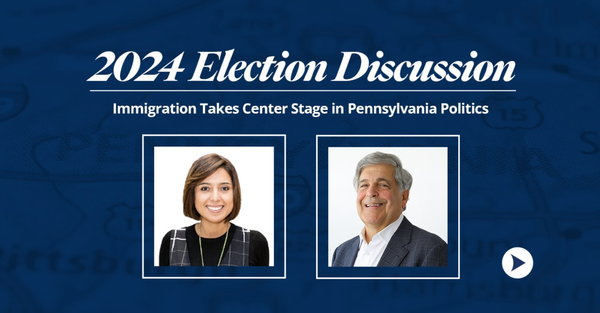Who are the Persuadables Who Need to Hear Biden Talk and Act on Immigration, Not Just Border

Beatriz Lopez, Deputy Director of the Immigration Hub
Recently, The New York Times’ Nate Cohn compared the 1948 election cycle to this year’s presidential race, naming an important differentiating factor between candidate Harry Truman and President Joe Biden: persuadable voters. Back then, these persuadable voters didn’t exist, but today they’re critical targets that are necessary to Biden’s coalition and swing an election in tight congressional races. Cohn paints the picture of what’s at stake as he concludes:
… [R]emember we’re talking about a persuadable group of voters, not single-issue voters. We can’t assume that, just because the economy improves, it means Biden’s going to win. There are other issues that can sway these voters — the border, Biden’s age, the war in Israel, or something else. It’s not so0 simple as to say that their vote will be dictated exclusively by the economy. But I think it’s fair to say that, with all of the huge issues that loom over the country today and how polarized our country is, that an improving economy may not be the same kind of wind in Joe Biden’s sales that it was for Harry Truman in 1948.
The Immigration Hub has long urged political analysts, candidates and elected officials to embrace the issue of immigration, not as a political loser or a scary wedge issue, but as a strength to mobilize and persuade key voting blocs against Donald Trump and radically right-wing politicians.
The essential lesson of successful campaigns is acknowledging there are segments of voters who need to hear boldly sensible and values-based narratives against far right, radical attacks on immigration. It’s just not worth ignoring the issue or the voters, or least of all adopt extreme language that fails to distinguish oneself from Trump-candidates. At the end of 2023, the Hub finalized a major year-long study with BlueLabs Analytics where we identified who these persuadable voters are, what and where they’re consuming their information and, most importantly, what immigration messaging works best to persuade them.
The findings revealed eight segments of voters: a Democratic, progressive base that doesn’t need persuasion on the issue; a group of receptive conservatives that could move over a longer period of time; and two other blocs who were far right on the issue and would ignore our overtures because of either their love of Trump or their aversion to immigrants and people of color.
And then there are the finicky four:
- At-Risk Base are strong Democrats that are very diverse, with almost 80% of the segment being African American, Latino or Asian American and Pacific Islander. The group is also defined by skewing female, young, and non-college educated. Two in three of these voters are under the age of 40—the youngest of our segments—and live in more urban areas. While this highly-online group (mostly on Tik-Tok) is highly pro-immigrant and not racially resentful, they are oh-so unpolitically engaged. They are prime for the Democratic picking, but not politically thrilled or motivated.
- Conflicted Dems are women, African-American, middle aged, and less college-educated and they reside in metropolitan areas, especially in the southern states such as North Carolina and Georgia. These voters show up in midterms and are predicted to be as politically engaged as the average voter. This segment, primarily made of middle-aged Black women, should hear what Democrats are doing to address the issue, which is why they align with messaging that speaks to values-based immigration solutions to our broken system.
- Unengaged Youth over-index as female, independent, Latino/a—though the majority are white—, non-college educated and young. Almost 60% of this group is under the age of 40, within striking distance to At-Risk Base voters, but this group is less diverse and less urban in comparison. The most essential characteristics of this segment are their lack of political engagement (with less than 40% voting at least once in the past two general elections) and their middling views on immigration and racial resentment – meaning their opinions haven’t fully crystallized on the issues of immigration and race. Bottom line, they are an opportunity-electorate that the Democrats should seize through persuasion on the issue, focusing on the intersection of immigration solutions and the economy.
- Immigration Side-liners, lastly, are most reflective of the persuasion targets from the 2020 elections: they skew slightly male, primarily white, middle-aged, and non-college educated, and are split living in suburban and rural areas. While the majority are likely Democrats, a plurality are independents. These voters are spread across the country but over-index in the Midwest and Northeast, making up 11% of registered voters in the Rust Belt battlegrounds. They are starving to hear Democrats talk about how rebuilding our immigration system and securing our border is key to our nation’s economic success and competitiveness.
If the latest ABC/Ipsos poll is any indication of how the Biden campaign and Democrats should message on immigration - given that voters blame both parties for the Senate border bill’s failure to pass - the secret sauce is to go on offense by messaging beyond the border, centering the economic and local contributions of hard-working immigrants in our country, a pathway to citizenship, orderly and humane solutions at the border, and a promising vision that contrasts from Trump’s heinous and destructive plans to separate families and deport Dreamers and immigrants en masse.
The Hub’s data-driven message formula works with these critical segments of persuadables. President Biden, Democrats, and sensible candidates who want to defeat Donald Trump and his ilk shouldn’t shy away from the issue or rush to the far right of it in an attempt to out-Trump Trump. Key to this winning blueprint and reaching these persuadables effectively is the willingness to understand your audience, deliver action, socialize the message(s), and keep repeating.
From now until November, President Biden and Democrats have an opportunity to not only talk the talk, but - urgently - act by offering lasting protections to Dreamers and long-settled immigrants in America to rebuild and turn out their coalition of base and persuadable voters. We can no longer define elections or the electorate by one-issue. Thus, pivoting away from immigration is a losing strategy. In a time when hard-working immigrants have waited too long for congressional action and a fragmented media landscape influences the public in different ways, messaging on immigration - and striking the right formula - is essential to mobilizing persuadable voters.




